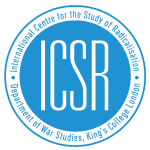The full report can be accessed here. An overview of its findings can be found here.
Please read on for the Executive Summary.
- Propaganda has long been central to violent jihadi groups as a means to disseminate their ideology, terrify their enemies, attract recruits and collect donations. However, never have jihadists used this tool more aggressively and effectively than they do today, especially in Syria. This study illustrates how Hayat Tahrir al-Sham (HTS) has been more prolific than other violent jihadi groups in its deployment or use of in-theatre propaganda and offline public diplomacy to increase its power and popularity as well as to entrench itself systematically within the local body politic.
- While its offline outreach operations include producing and distributing media products, HTS prefers to share its ideological principles and sociopolitical values through long-term education and outreach activities. Towards that end, the group has invested a huge amount of time and energy in communicating with the local population, utilising dozens of scholars who regularly attend public dawa gatherings and campaigns.
- HTS’s in-theatre public diplomacy activities have tended to rely heavily on already-extant structures and institutions such mudafat, du’at al-jihad [callers to jihad], sawaed al-khir [Goodwill Corps] and the Salvation Government, which continue to operate semi-autonomously and rarely fall under the group’s official authority. By outsourcing such functions, the group has been able to save resources, specifically by limiting expenditure, thereby becoming a more decentralised – and therefore elusive – target for counter-narrative communication operations.
- Similarly, the group has been actively trying to distance itself from its somewhat in-house propaganda institutions, such as the Ebaa network and maktab al-dawa wa al-irshad [Dawa and Guidance Office]. Despite the common knowledge that those institutions are directly linked to HTS, the latter still attempts to present them as external organisations. This approach aims to enable its proxy media officials to propagandise on its behalf while themselves masquerading as independent actors.
- Instead of adopting a totalitarian approach towards censorship, which likeminded groups tend to do by banning anything not published by the group, HTS has been both less ambitious and more cautious, preferring to preserve relationships through more targeted negative measures. Through this gradualist and selective censorship, HTS and its antecedents have worked systematically to become one of the few hegemons in northern Syria’s information landscape. While it remains far out of reach of a true information monopoly, the targeted damage it has inflicted upon the public discourse in its territories is likely to have lasting consequences.
- Understanding how HTS uses its strategic communication is a necessary step towards countering the group and its ideology. Towards that end, those involved should develop a better understanding of the various narratives and tactics the group uses to increase its legitimacy, credibility and popularity, which can then be used to develop a comprehensive, multi-strategy, online and in-theatre, approaches.
This report was written by Haid Haid.
